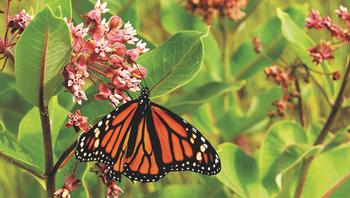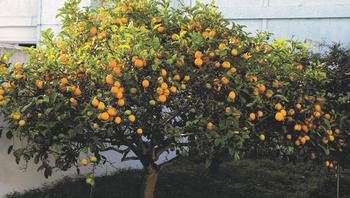Autumn in the Garden
-
Wendy Irving
-
Autumn is a beautiful time of year to putter and plan in the garden - cooler temperatures, crisp, clean air (if no wildfires are raging anywhere), and the anticipation of life-giving rain! It is the right time of year to plant new trees and shrubs, do some pruning and cleanup, prepare for potential winter cold, and get started on your cool-season vegetable garden.
 Milkweed, which attracts monarch butterflies, should die completely back by late fall. If it doesn’t, prune it back to a few inches. Colin Mackenzie
Milkweed, which attracts monarch butterflies, should die completely back by late fall. If it doesn’t, prune it back to a few inches. Colin MackenzieIf you must plant a new tree or shrub, do it now. You may not see much new growth, but the point is to establish a strong root system. With the soil still warm, the temperatures generally cooler, the days shorter, and rainfall imminent (we hope!), new trees and shrubs planted in fall have the best chance of adapting to their new space and having a healthy future. And as leaves start to fall from established deciduous trees and shrubs, keep things clean, avoiding any buildup of debris around the crowns.
Autumn brings a few pruning chores but not many. As a general rule, late winter is the best time to prune non-native summer/fall flowering trees and shrubs, including deciduous and fruit trees and roses. Not necessarily true for natives. Go to Marin Master Gardeners or the California Native Plant Society Websites for more details on pruning native plants. And with all the interest in bringing back monarch butterflies to Marin, it has been determined that pruning native milkweed down in the fall (November) is essential to maintaining the monarch's natural migration pattern. Don't plant non-native milkweed in your garden at all or any milkweed within five miles of the coast (coastal areas are overwintering sites for the butterfly).
But autumn is an excellent time to think about the 4 D's – dead, diseased, damaged, or dysfunctional parts of plants and trees. Upcoming rains and windstorms make affected trees and plants more vulnerable and potentially dangerous, so prune them if necessary.
Citrus trees need some attention at this time of year. Continue to irrigate if required. Do not apply nitrogen (which promotes growth), as an early frost may damage tender new leaves. Watch the weather forecasts and make sure your tree is well watered if temperatures sink. Check for ripening fruit of early varieties and harvest it. Remember, unlike other fruits, citrus does not continue to ripen and get sweeter after it is picked. Ripe fruit will generally be fully colored and easy to remove from the tree, but taste testing is the best judge. To maintain a healthy, productive tree, remove fruit as it matures. On frosty nights, cover your trees to protect them with canopies made of wood stakes and canvas (not plastic). Now is the time of year to make sure your supplies of materials that you might want to use to protect any of your cold-sensitive plants and vegetables are handy and in good shape. Many citrus trees are ready for harvesting in the fall and winter months, when fruit is ripe. Photo: Localaccent
Many citrus trees are ready for harvesting in the fall and winter months, when fruit is ripe. Photo: LocalaccentSpeaking of vegetables, fall is the time to prepare your garden for cool season veggies such as broccoli, kale, beets, spinach, chard, lettuce, and salad greens. If you haven't already started some of your cool season vegetables from seed, you might be a little late, but you should be able to find small plants in your local nursery. Suppose you've been tending your vegetable garden well all summer, weeding and removing old or diseased plants. In that case, you generally won't need to do much to prepare your fall/winter beds ? a little cleanup and adding some rich organic soil or compost, and you are ready to go.


